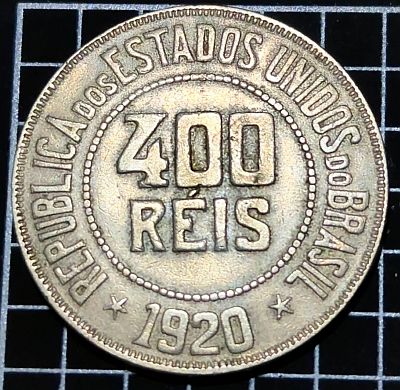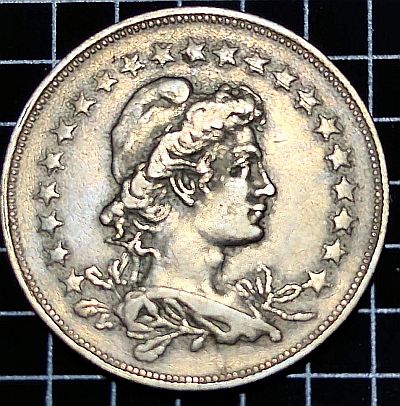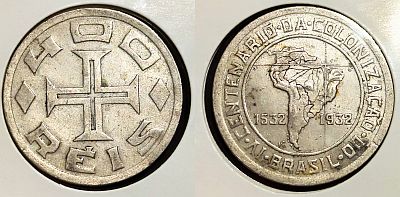An interesting denomination and female personification of Liberty
This is my entry for Day 2 “B” of the Blogging from A-Z April Challenge!
B = Brazil.

Obverse

We’ve previously looked at the 1835 Brazil 40 Réis (which was countermarked on an 80 Réis). At the time that coin was issued, Brazil had only recently achieved independence from Portugal, to become a monarchy themselves. A young Pedro II was Emperor. Fifty-years later, however, the winds of change were blowing. In 1889, the military staged a coup and proclaimed Brazil a republic. Pedro II (who was still monarch) abdicated and went into exile in Europe. Between 1888 and 1922 a period of change and accelerated modernisation ensued, described as the emergence of the “New Brazil”. Towards the end of this period, in 1920, this 400 Réis coin was minted.
The obverse featured solely text: REPUBLICA DOS ESTADOS UNIDOS DO BRASIL around the outside, the value 400 and RÉIS in the centre, and the year 1920 at the bottom. The text around the outside is in Brazilian Portuguese. It translates as “Republic of the United States of Brazil”. The first thing it reminds me of is the wording of Mexican coins, which read “Estados Unidos Mexicanos” which is Spanish for “United States of Mexico” (The place we call the USA is not the only “United States”!)
I do also like interesting fonts, so I am a big fan of the style of the 4 in 400 on this piece.
Reverse

As a fan of fonts, however, there are none to admire on the reverse, but it is perhaps all the more striking for all that. If you learn nothing else from my blog, you’ll probably learn the word “Anepigraphic” (Without legend or inscription). In contrast to my previous assertion about fonts, I also really like anepigraphic coins. So the image on this side of the coin is Lady Liberty, facing right, wearing a “Phrygian” liberty cap, with a border of 21 stars. When the first republic of Brazil was declared in 1889, there were 21 states, hence, one star for each state. The 1889 flag of Brazil also has 21 stars on it. (Hat tip to Tom, the Blind Coin Collector for pointing me in the right direction on this!)
Lady Liberty has a long history with republics, and with coins. In Ancient Rome, Libertas was the female personification of liberty and personal freedom. Roman Coins featuring Libertas go back to (as indicated in the link), the time of Julius Caesar. Many other nations use similar symbolism. Marianne is the French symbol of the Republic. The United States of America has the Statue of Liberty. In fact, there are actually multiple “statues of liberty” around the world. Brazil has one of the few replicas that was actually made by the original designer.
There haven’t been many coins with the denomination of “400”. Those that have been created primarily come from Portugal, and Portuguese territories (or former territories in this case). 400 Réis equalled 1 Cruzado in Portugal and territories, with the last issue of this value in 1942 in Brazil.
A bonus extra piece: One of my other favourite Brazilian 400 Réis coins was issued while this piece was being minted. A circulating commemorative, issued in 1932 to commemorate the 500th anniversary of Portuguese colonisation of Brazil, this coin features the Cross of the Order of Christ common to many Portuguese and especially Portuguese colonial coins:

What do you think is the most interesting denomination which is perhaps used elsewhere in the world, or was common historically? Share your thoughts below.


Leave a Reply